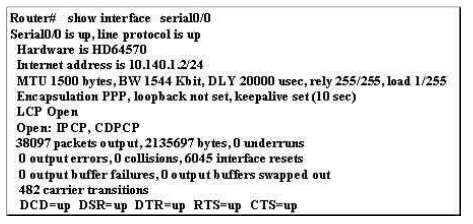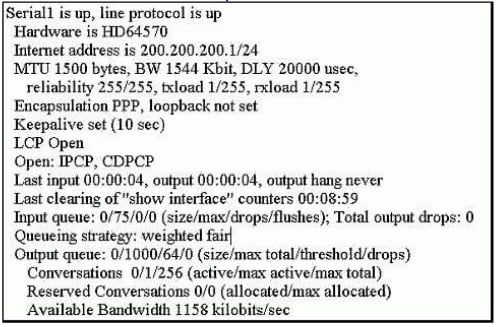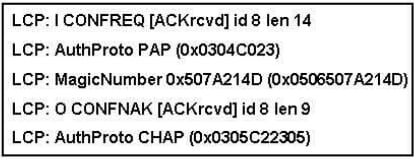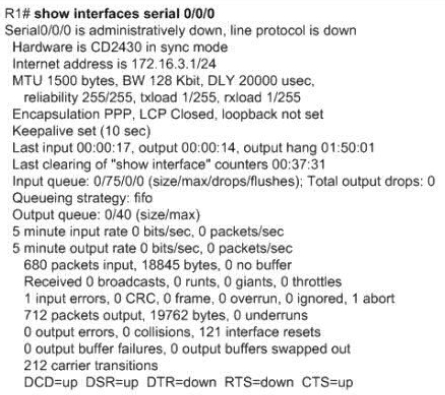CCNA WAN Chapter 2
-
Which two statements are true about time-division multiplexing (TDM)? (Choose two.)
-
TDM relies on Layer 3 protocols to operate.
-
Multiple sources can transmit over a single channel.
-
Original data streams must be reconstructed at the destination.
-
TDM methods vary depending on the Layer 2 protocol that is used.
-
It allows information from multiple channels to be allocated bandwidth on multiple wires
-

Welcome to the second chapter of your ongoing studies on the wide area network – a computer network which spans a large area, connecting devices within a radius over a kilometre long. What else can you tell us about these networks? Take the quiz now and hopefully boost your progress towards the CCNA!
Quiz Preview
- 2.
What does the demarcation point represent in data communication physical circuits?
-
DTE/DCE interface on the device connecting to the Internet
-
Location of the firewall or router
-
Physical point at which the public network ends and the private customer network begins
-
Tag assigned to the physical block where a cross-connect occurs
Correct Answer
A. Physical point at which the public network ends and the private customer network beginsExplanation
The demarcation point in data communication physical circuits represents the physical point at which the public network ends and the private customer network begins. This is the point where the responsibility for the network switches from the service provider to the customer. It is typically located at the customer premises and is used to separate the public network infrastructure from the customer's private network.Rate this question:
-
- 3.
Which serial communications DTE/DCE interface standard is used to provide high-speed connectivity of up to 52 Mbps between LANs and is found on many high-end Cisco routers?
-
EIA/TIA 232 (RS-232)
-
EIA/TIA 422 (RS-422)
-
EIA/TIA 423 (RS-423)
-
EIA/TIA-612/613 (HSSI)
-
ITU V.35
Correct Answer
A. EIA/TIA-612/613 (HSSI) -
- 4.
Why are serial connections preferred over parallel connections for long transmission lengths?
-
Parallel connections do not support error checking.
-
Parallel connections are subject to excessive attenuation.
-
Parallel connections are subject to clock skew and to crosstalk between wires.
-
Parallel connections transmit over only two wires and therefore transmit data more slowly.
Correct Answer
A. Parallel connections are subject to clock skew and to crosstalk between wires.Explanation
Parallel connections are subject to clock skew and crosstalk between wires. Clock skew refers to the difference in arrival time of signals in parallel wires, which can result in data corruption. Crosstalk occurs when signals from one wire interfere with signals on adjacent wires, leading to data errors. These issues become more prominent with longer transmission lengths, making serial connections a preferred choice as they minimize clock skew and crosstalk.Rate this question:
-
- 5.
Which three statements are correct about HDLC encapsulation? (Choose three.)
-
HDLC does not support CDP.
-
HDLC supports PAP and CHAP authentication.
-
HDLC implementation in Cisco routers is proprietary.
-
HDLC is the default serial interface encapsulation on Cisco routers.
-
HDLC uses frame delimiters to mark the beginnings and ends of frames.
Correct Answer(s)
A. HDLC implementation in Cisco routers is proprietary.
A. HDLC is the default serial interface encapsulation on Cisco routers.
A. HDLC uses frame delimiters to mark the beginnings and ends of frames.Explanation
The three correct statements about HDLC encapsulation are:
1. HDLC implementation in Cisco routers is proprietary. This means that Cisco has developed its own version of HDLC for use in their routers, which may not be compatible with other vendors' equipment.
2. HDLC is the default serial interface encapsulation on Cisco routers. This means that when a serial interface is configured on a Cisco router, HDLC is automatically used as the encapsulation method unless another method is specified.
3. HDLC uses frame delimiters to mark the beginnings and ends of frames. Frame delimiters are special characters or bit patterns that are used to indicate the start and end of a frame in the HDLC protocol.Rate this question:
-
- 6.
Which three statements are true regarding LCP? (Choose three.)
-
It is responsible for negotiating link establishment.
-
It negotiates options for Layer 3 protocols running over PPP.
-
It uses MD5 encryption while negotiating link establishment parameters.
-
It terminates the link upon user request or the expiration of an inactivity timer.
-
It can test the link to determine if link quality is sufficient to bring up the link
Correct Answer(s)
A. It is responsible for negotiating link establishment.
A. It terminates the link upon user request or the expiration of an inactivity timer.
A. It can test the link to determine if link quality is sufficient to bring up the linkExplanation
LCP, or Link Control Protocol, is responsible for negotiating the establishment of a link between two devices. It is also responsible for terminating the link either upon user request or when an inactivity timer expires. Additionally, LCP can test the link to determine if the link quality is sufficient to bring up the link.Rate this question:
-
- 7.
Which two options can LCP negotiate? (Choose two.)
-
Link quality
-
Authentication
-
Dynamic flow control
-
Compression and network layer address for IP
-
Connection-oriented or connectionless communication methods
Correct Answer(s)
A. Link quality
A. AuthenticationExplanation
LCP (Link Control Protocol) is responsible for establishing and configuring a data link connection between two devices. It can negotiate link quality, which refers to the reliability and performance of the link, and authentication, which involves verifying the identity of the devices involved in the connection. LCP does not negotiate dynamic flow control, compression and network layer address for IP, or connection-oriented or connectionless communication methods. Therefore, the correct options are link quality and authentication.Rate this question:
-
- 8.
Which PPP configuration option can be used to establish load balancing over the interfaces of a router?
-
Callback
-
Multilink
-
Compression
-
Error detection
Correct Answer
A. MultilinkExplanation
Multilink is the correct answer because it allows load balancing over the interfaces of a router. By combining multiple physical interfaces into a single logical interface, multilink enables the distribution of traffic across these interfaces, thereby achieving load balancing. This helps in optimizing network performance and utilization by utilizing the available bandwidth of multiple links simultaneously.Rate this question:
-
- 9.
What function do Network Control Protocols provide for a PPP connection?
-
To supply error detection
-
To establish and terminate data links
-
To provide authentication capabilities to PPP
-
To manage network congestion and to allow quality testing of the link
-
To allow multiple Layer 3 protocols to operate over the same physical link
Correct Answer
A. To allow multiple Layer 3 protocols to operate over the same physical linkExplanation
Network Control Protocols (NCPs) provide the function of allowing multiple Layer 3 protocols to operate over the same physical link in a PPP connection. This means that different network protocols, such as IP, IPX, or AppleTalk, can be used simultaneously over a single PPP connection. NCPs handle the negotiation and configuration of these protocols, ensuring that each protocol can communicate effectively over the shared link. This allows for efficient and flexible network connectivity, as multiple protocols can coexist and operate independently over the same physical connection.Rate this question:
-
- 10.
Refer to the exhibit. On the basis of the show interface Serial0/0 output, how many NCP sessions have been established?
-
One
-
Two
-
Three
-
Four
Correct Answer
A. TwoExplanation
Based on the show interface Serial0/0 output, the NCP (Network Control Protocol) sessions are established between two devices. The exhibit does not provide any information about additional sessions beyond the two mentioned, so the correct answer is two.Rate this question:
-
- 11.
Refer to the exhibit. Which statement is true about PPP operation?
-
Layer 2 is down.
-
LCP, IPCP, and CDPCP negotiations are in progress.
-
Only the link-establishment phase completed successfully.
-
Both the link-establishment and network-layer phase completed successfully.
Correct Answer
A. Both the link-establishment and network-layer phase completed successfully.Explanation
The exhibit is not provided, so it is difficult to give a specific explanation for the correct answer. However, based on the given options, the statement "Both the link-establishment and network-layer phase completed successfully" is true about PPP operation. This means that both the physical link between the devices and the network layer protocols have been successfully established and are operational.Rate this question:
-
- 12.
Which three statements correctly describe PPP authentication? (Choose three.)
-
PAP sends passwords in clear text.
-
PAP uses a 3-way handshake to establish a link.
-
CHAP uses a 2-way handshake to establish a link.
-
CHAP uses a challenge/response that is based on the MD5 hash algorithm.
-
CHAP uses repeated challenges for verification.
Correct Answer(s)
A. PAP sends passwords in clear text.
A. CHAP uses a challenge/response that is based on the MD5 hash algorithm.
A. CHAP uses repeated challenges for verification.Explanation
PAP sends passwords in clear text, meaning that the password is not encrypted and can be easily intercepted. CHAP uses a challenge/response mechanism based on the MD5 hash algorithm, which provides a more secure authentication process. This ensures that the password is not sent in clear text and is protected. Additionally, CHAP uses repeated challenges for verification, where the authentication server sends multiple challenges to the client for further verification, enhancing security.Rate this question:
-
- 13.
Which authentication protocol can be spoofed to allow playback attacks?
-
MD5
-
CHAP
-
PAP
-
NCP
Correct Answer
A. PAPExplanation
PAP (Password Authentication Protocol) can be spoofed to allow playback attacks. PAP is a weak authentication protocol that sends passwords in clear text, making it vulnerable to interception and replay attacks. In a playback attack, an attacker intercepts and records the authentication process, then replays it later to gain unauthorized access. This can be done because PAP does not provide any means of verifying the freshness or authenticity of the authentication request.Rate this question:
-
- 14.
Refer to the exhibit. What statement is true regarding the output shown?
-
LCP is in the process of negotiating a link.
-
LCP and NCP are waiting for CHAP authentication to complete.
-
LCP negotiation has been successful, but NCP negotiation is in progress.
-
Data is able to flow across this link.
Correct Answer
A. Data is able to flow across this link.Explanation
The output shown indicates that LCP negotiation has been successful, which means that the link has been established and data is able to flow across this link. The fact that LCP and NCP are waiting for CHAP authentication to complete does not affect the ability of data to flow across the link.Rate this question:
-
- 15.
Refer to the exhibit. What statement is true regarding the output shown?
-
NCP has successfully negotiated.
-
The PAP passwords did not match, so the routers are trying CHAP authentication.
-
One router has suggested PAP authentication, and the other has accepted authentication but suggested CHAP authentication.
-
One router can only use PAP authentication while the other router can only use CHAP, so the connection has been rejected.
Correct Answer
A. One router has suggested PAP authentication, and the other has accepted authentication but suggested CHAP authentication.Explanation
The output indicates that one router has suggested PAP authentication and the other has accepted authentication but suggested CHAP authentication. This means that the routers are trying to negotiate the authentication method, with one router preferring PAP and the other preferring CHAP.Rate this question:
-
- 16.
-
The router has agreed on IP parameters.
-
The router has negotiated LCP successfully.
-
The router is negotiating IP compression options.
-
The router is requesting an IP address from its peer.
-
The router has accepted IP but not the suggested IP options.
Correct Answer(s)
A. The router has agreed on IP parameters.
A. The router has negotiated LCP successfully. -
- 17.
What advantage does PPP have over HDLC for serial communications?
-
It can communicate more efficiently with other Cisco devices
-
It is less complex to configure
-
It has less Layer 2 overhead
-
It supports authentication
Correct Answer
A. It supports authenticationExplanation
PPP has an advantage over HDLC for serial communications because it supports authentication. This means that PPP can verify the identity of the devices involved in the communication, ensuring a secure and trusted connection. Authentication helps prevent unauthorized access and protects the integrity of the data being transmitted. HDLC, on the other hand, does not have built-in authentication capabilities, making it less secure in comparison.Rate this question:
-
- 18.
Refer to the exhibit. While troubleshooting a serial interface, a technician enters the command show interface serial 0/0/0 . If the interface is in DCE mode, what two problems are likely to cause the indicated problem? (Choose two.)
-
The remote CSU or DSU has failed.
-
The router is not sensing a CD signal.
-
A timing problem has occurred on the cable.
-
The line is not physically connected to the CSU/DSU.
-
The router configuration contains the shutdown interface configuration command.
Correct Answer(s)
A. The remote CSU or DSU has failed.
A. A timing problem has occurred on the cable.Explanation
If the interface is in DCE mode, the remote CSU or DSU failing could cause the indicated problem. The CSU/DSU is responsible for connecting the router to the WAN circuit, so if it fails, the interface will not be able to establish a connection. Additionally, a timing problem on the cable could also cause the issue. Timing problems can occur when the clocking settings on the router and the CSU/DSU do not match, leading to synchronization issues and a failure to establish a connection.Rate this question:
-
- 19.
Refer to the exhibit. Router R1, the DCE device, has just been configured for PPP encapsulation with authentication. What series of commands will allow another router, the DTE device, to communicate over its serial 0/0/0 interface to router R1?
-
Router(config)# hostname R3 R3(config)# username R1 password Cisco R3(config)# interface Serial 0/0/0 R3(config-if)# encapsulation ppp R3(config-if)# ip address 172.16.3.3 255.255.255.0 R3(config-if)# ppp authentication chap
-
Router(config)# hostname R3 R3(config)# username R3 password Cisco R3(config)# interface Serial 0/0/0 R3(config-if)# encapsulation ppp R3(config-if)# ip address 172.16.3.3 255.255.255.0 R3(config-if)# ppp authentication chap
-
Router (config)# username Router password Cisco Router (config)# interface Serial 0/0/0 Router (config-if)# clockrate 64000 Router (config-if)# encapsulation ppp Router (config-if)# ip address 172.16.3.1 255.255.255.0 Router config-if)# ppp authentication chap
-
Router (config)# username R1 password Cisco Router config)# interface Serial 0/0/0 Router (config-if)# clockrate 64000 Router config-if)# encapsulation ppp Router (config-if)# ip address 172.16.3.1 255.255.255.0 Router (config-if)# ppp authentication chap
Correct Answer
A. Router(config)# hostname R3 R3(config)# username R1 password Cisco R3(config)# interface Serial 0/0/0 R3(config-if)# encapsulation ppp R3(config-if)# ip address 172.16.3.3 255.255.255.0 R3(config-if)# ppp authentication chapExplanation
The correct series of commands will allow router R3 to communicate over its serial 0/0/0 interface to router R1. First, the hostname is set to R3. Then, a username and password are configured for the authentication process, with the username set as R1 and the password set as Cisco. Next, the interface Serial 0/0/0 is configured with the encapsulation set to PPP. An IP address is assigned to the interface, followed by the command to enable CHAP authentication. This series of commands ensures that router R3 is properly configured to communicate with router R1 over the serial connection.Rate this question:
-
- 20.
Refer to the exhibit. Router R1 is not able to communicate with a neighbor router that is directly connected to serial 0/0/0. What is the reason for this?
-
Interface Serial0/0/0 resets very frequently.
-
PPP LQM has shutdown the serial interface.
-
The serial interface has no input or output queues available.
-
The serial interface is not configured for a Layer 2 protocol.
-
The interface has been administratively shutdown with the shutdown command.
Correct Answer
A. The interface has been administratively shutdown with the shutdown command.Explanation
The reason why Router R1 is not able to communicate with the neighbor router is that the interface has been administratively shutdown with the shutdown command. This means that the interface is intentionally disabled by an administrator, preventing any communication through that interface.Rate this question:
-
- 21.
Refer to the exhibit. What can be concluded about the function of the Serial 0/0/0 interface on the router after the commands are entered?
-
All username and password information that is sent will be encrypted.
-
All authentication on the serial link will be accomplished using a three-way handshake.
-
The Predictor algorithm will be used to compress all packets that are sent and received on the serial link.
-
The serial link will be closed if the number of received packets at the destination node falls below 90 percent of the packets that are sent.
Correct Answer
A. The serial link will be closed if the number of received packets at the destination node falls below 90 percent of the packets that are sent.Explanation
The given exhibit does not provide any information about encryption, authentication, or the use of the Predictor algorithm. However, it states that the serial link will be closed if the number of received packets at the destination node falls below 90 percent of the packets that are sent. Therefore, the correct answer is that the serial link will be closed if the number of received packets at the destination node falls below 90 percent of the packets that are sent.Rate this question:
-
Quiz Review Timeline (Updated): Mar 21, 2023 +
Our quizzes are rigorously reviewed, monitored and continuously updated by our expert board to maintain accuracy, relevance, and timeliness.
-
Current Version
-
Mar 21, 2023Quiz Edited by
ProProfs Editorial Team -
Apr 05, 2010Quiz Created by
Rodney.butler
 Back to top
Back to top










